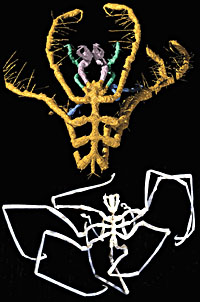 | Scientists used computer reconstruction to create this image of the ancient Haliestes species of sea spider (above left, artificially colored), and a modern sea spider, Nymphon (bleached, below left), which is about 50% larger and has longer legs. |
Volcanic ash that encased and preserved sea life in the Silurian age 425 million years ago near Herefordshire, United Kingdom, has yielded fossils of a new species of ancient sea spider, or pycnogonid, one of the most unusual types of arthropod in the seas today.
Sea spiders are soft-bodied arthropods found widely in modern oceans. For two centuries there has been a controversy about the relationship of sea spiders to land spiders, scorpions, ticks and mites because of their unique body form. Sea spiders have a long proboscis and unusual limb structures, which are used in mating and carrying brooding embryos. The fossil record of their relationship is sparse because of their delicate nature.
"This is the earliest adult fossil example, and it is preserved in extraordinary detail," says Derek Briggs, professor of geology and geophysics, and director of the Yale Institute of Biospheric Studies. "Volcanic ash that trapped ancient sea life in this location rapidly encased the creatures making a concrete-like cast of the bodies. The cavity later filled in with carbonate solids so we have a fossil record to study now."
To create a picture of the fossils, the specimens were ground away a few microns at a time. Each slice was digitally imaged, and then the whole creature was reconstructed using computer graphics. The reconstruction suggests that these exotic animals are indeed related to land spiders, scorpions, mites and ticks, says Briggs.
The new species, Haliestes dasos, represents the earliest known adult sea spider by 35 million years. Its large pincers place the sea spiders firmly within a larger grouping that includes scorpions, mites, ticks, the real spiders and the horseshoe crab, says Briggs. Even in ancient times, he adds, the new species appears to have lived in a similar way to modern ones -- on the seabed or perhaps on sponges.
The research was carried out as part of a project on the Herefordshire fauna by a team that included Briggs, Derek Siveter and Mark Sutton at Oxford University, and David Siveter at the University of Leicester. The group has made a number of other discoveries of soft-bodied organisms in the same deposit including crustaceans, a worm-like mollusc, a polychaete worm, a starfish, and other as-yet-unidentified organisms.
-- By Janet Rettig Emanuel
T H I S
Scientists discover fossil of
ancient sea spider species W E E K ' S
W E E K ' S S T O R I E S
S T O R I E S![]()
 Scientists discover fossil of ancient sea spider species
Scientists discover fossil of ancient sea spider species
![]()
![]()
 Center to continue studies on smoking with $9 million grant
Center to continue studies on smoking with $9 million grant
![]()
![]()
 Researchers have linked mitochondrial mutation . . .
Researchers have linked mitochondrial mutation . . .![]()
![]()
 Yale and presidential politics in 2004
Yale and presidential politics in 2004 Bulldogs part of presidential ticket for 32 years now
Bulldogs part of presidential ticket for 32 years now
![]()
 Scholar has advised politicians on how to 'get out the vote'
Scholar has advised politicians on how to 'get out the vote'
![]()
 Yale debate champ tapped to assess candidates' face-offs
Yale debate champ tapped to assess candidates' face-offs
![]()
![]()
 Grant supports F&ES students from underrepresented areas
Grant supports F&ES students from underrepresented areas
![]()
![]()
 Study finds that estrogen does not always help memory
Study finds that estrogen does not always help memory![]()
![]()
 Scientists devise a method to measure the age of Martian meteorites
Scientists devise a method to measure the age of Martian meteorites
![]()
![]()
 Researchers are studying role of brain in nicotine addiction
Researchers are studying role of brain in nicotine addiction
![]()
![]()
 Performance at Long Wharf marks launch of O'Neill at Yale project
Performance at Long Wharf marks launch of O'Neill at Yale project
![]()
![]()
 Beekman Cannon, advocate of musical life at Yale
Beekman Cannon, advocate of musical life at Yale
![]()
![]()
 Divinity School alumni are honored for ministry and service
Divinity School alumni are honored for ministry and service
![]()
![]()
 Yale Books in Brief
Yale Books in Brief
![]()
![]()
 Campus Notes
Campus Notes
![]()
Bulletin Home |
| Visiting on Campus
Visiting on Campus |
| Calendar of Events
Calendar of Events |
| In the News
In the News![]()
Bulletin Board |
| Classified Ads
Classified Ads |
| Search Archives
Search Archives |
| Deadlines
Deadlines![]()
Bulletin Staff |
| Public Affairs
Public Affairs |
| News Releases
News Releases |
| E-Mail Us
E-Mail Us |
| Yale Home
Yale Home